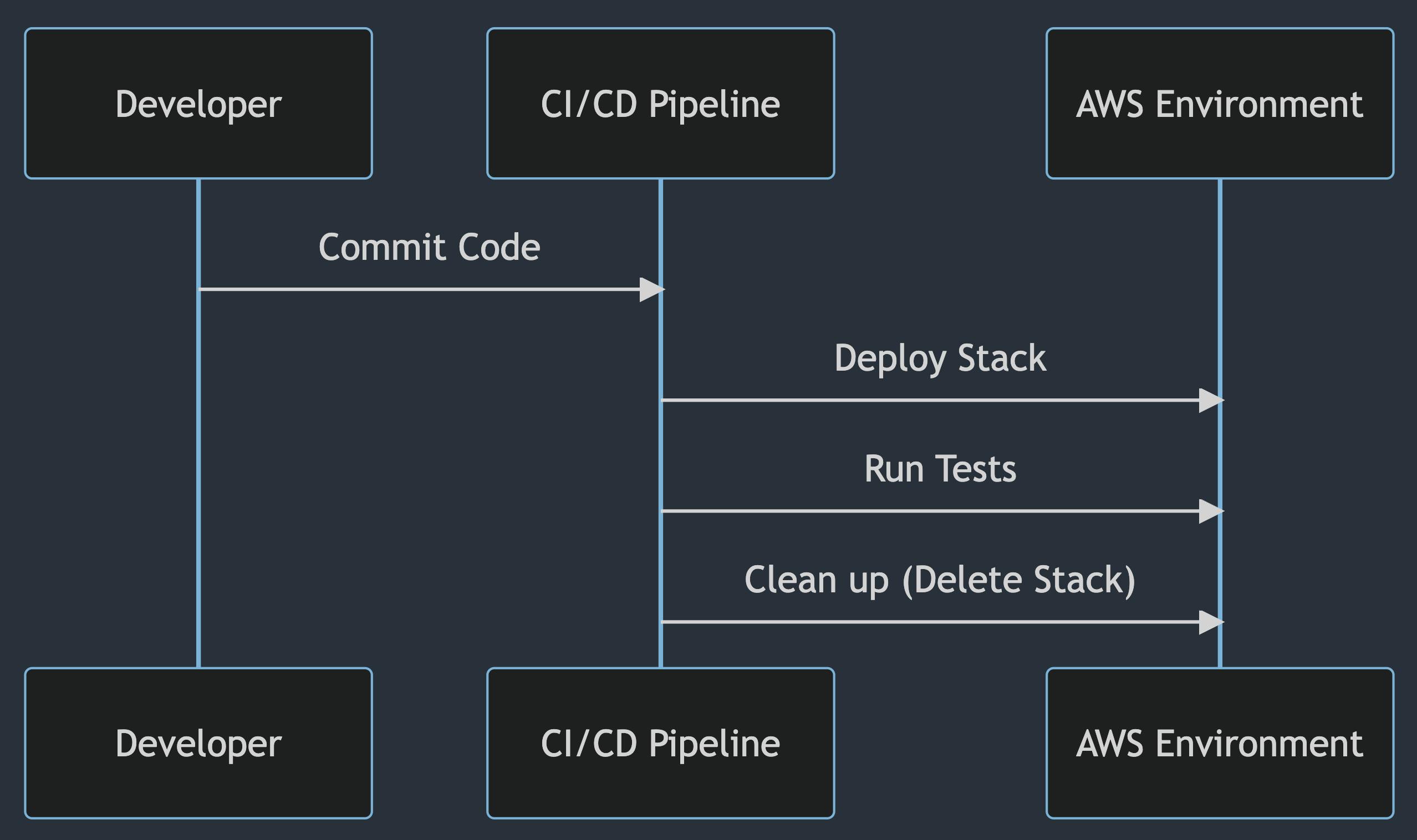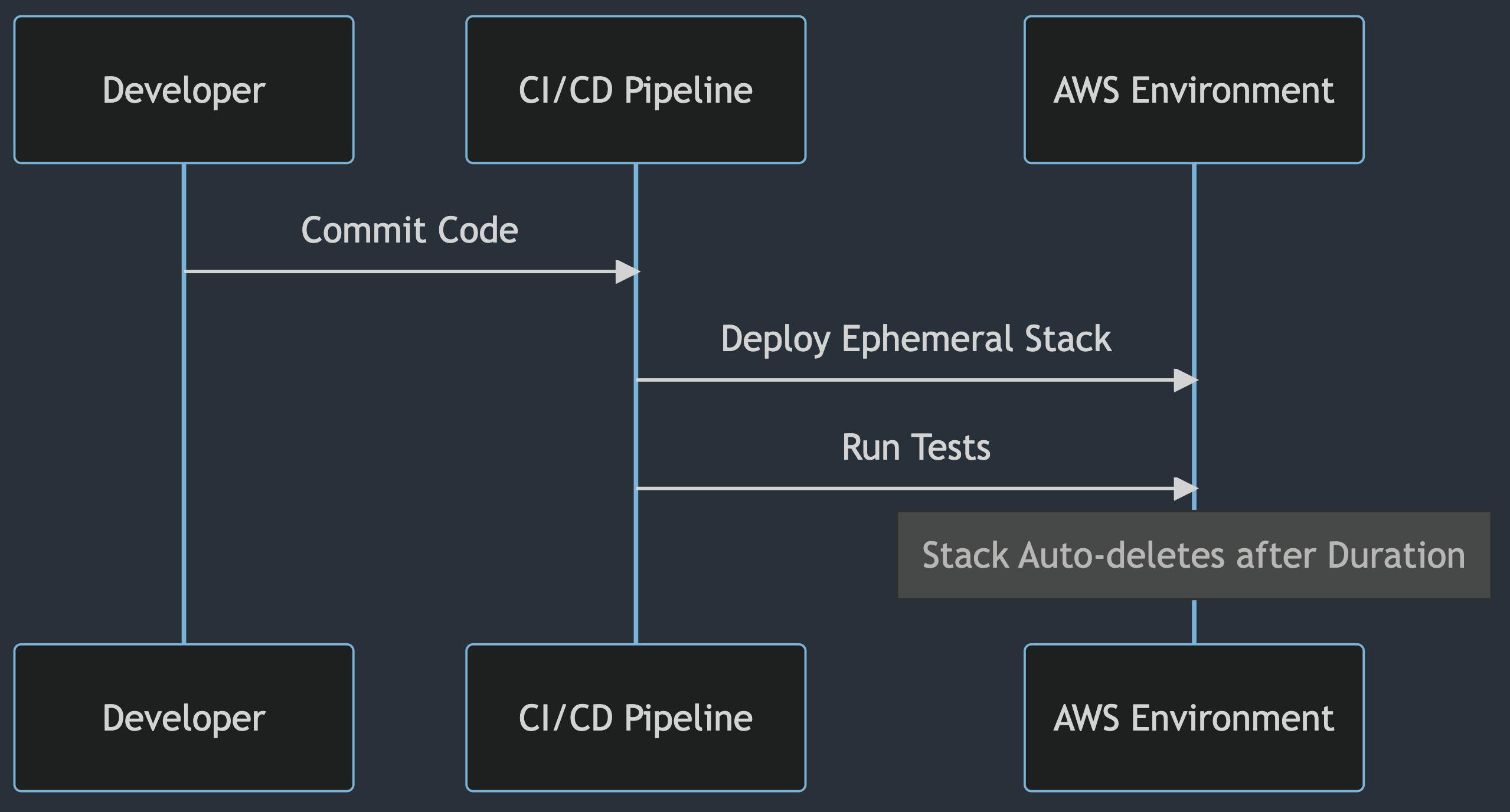
Photo by Dave Hoefler on Unsplash
Blink and It's Gone: Embracing Ephemeral CDK Stacks for Efficient DevOps
I'm excited to announce that I'll be speaking at AWS Summit Washington, DC on June 8th, 2023, at 2:15PM (DEV206). My DevChat will discuss the benefits of ephemeral CDK Stacks for development workflows and CI/CD pipelines. If you're attending, I'd love to see you there and answer any questions you might have.
This post serves as a supplement to my talk (spoilers), providing more insights into ephemeral CDK Stacks, their implementation, and best practices. If you're exploring the topic or haven't yet decided on attending the AWS Summit, I hope this post sparks your interest and encourages you to join me for an engaging discussion. See you there! 🎉
In the fast-paced DevOps world, managing and cleaning up temporary cloud resources can be challenging. Forgotten stacks from testing or PoC stages lead to resource wastage and inflated cloud bills. To address this, ephemeral AWS CDK Stacks are a game changer.
This blog post explores integrating ephemeral CDK Stacks into CI/CD pipelines and development workflows. Powered by Self-Destructing Constructs and CDK Aspects, they automate the cleanup process, ensuring a tidy AWS environment and resource savings.
Ephemeral stacks are a simple yet powerful addition to your DevOps toolkit, streamlining resource management and reducing costs. Let's dive into leveraging ephemeral stacks, saving you from manual cleanup and the perils of forgotten stacks.
Self-Destructing Construct and CDK Aspects
Ephemeral CDK Stacks are made possible by combining the concepts from two of my previous posts on Self-Destructing Constructs and CDK Aspects.
Self-Destructing Constructs: As discussed in my previous post, Say Goodbye to Your CDK Stacks: A Guide to Self-Destruction, these are unique AWS CDK constructs that employ Step Functions to automatically delete the stack after a defined duration. This construct helps ensure that unnecessary resources aren't lingering around, reducing costs and freeing up space in your AWS account.
CDK Aspects: My last post, Breaking Bad Practices with CDK Aspects, explained how CDK Aspects allow for implementing cross-cutting concerns across your stack, such as applying an aggressive removal policy to all resources. When paired with self-destructing stacks, this ensures a clean slate post-destruction, leaving no stray resources behind.
Integrating Ephemeral Stacks with CI/CD Pipelines
CI/CD pipelines, a cornerstone of modern DevOps practices, can greatly benefit from ephemeral CDK Stacks. In a typical CI/CD pipeline, each code commit triggers a process that includes building, testing, and deploying the application. This often involves deploying a stack and, once the tests are executed, cleaning up the resources.
However, sometimes stacks are left behind due to failures in the pipeline or prematurely terminated tests. These forgotten stacks lead to unnecessary costs and clutter. Ephemeral stacks resolve this by auto-deleting after a specific duration, ensuring a clean AWS environment and reducing the wastage of resources.
To illustrate this, let's compare the sequence of events in a typical CI/CD pipeline and one enhanced with ephemeral stacks.
Typical CI/CD pipeline:

In the traditional CI/CD pipeline, the stack is explicitly deleted as part of the pipeline, which could fail or be skipped, resulting in lingering stacks.
CI/CD pipeline with Ephemeral Stacks:

With ephemeral stacks, the stack deletion is automated and independent of the CI/CD pipeline, ensuring that stacks are always cleaned up.
This approach reduces the complexity of your CI/CD pipeline and ensures cleaner resource management in your AWS environment. Additionally, you can set up an aggressive removal policy using CDK Aspects for a more comprehensive cleanup of all resources associated with the stack.
It doesn't sound like a lot, but in practice, it can save hours (over the course of weeks) while ensuring AWS resources (and money) aren't being wasted. 🚀
Implementing Ephemeral Stacks in Development Workflows
Developers often deploy proof of concept (PoC) stacks to test new features, validate concepts, or debug issues. These stacks provide a sandboxed environment to experiment without affecting the production infrastructure. However, once the purpose is served, these stacks often become "forgotten" entities in the cloud environment. They no longer serve a meaningful purpose and, over time, contribute to clutter and unnecessary costs. Implementing ephemeral stacks in development workflows can be an excellent solution to this common oversight.
The Problem of Forgotten Stacks
In the energetic world of development work, the adrenaline rush of solving complex problems or moving onto the next exhilarating task can often eclipse the essential, albeit less exciting, cleanup step. This oversight, often spurred by the thrill of innovation 💡 or the satisfaction of squashing a bug 🐛, can lead to the pile-up of forgotten temporary stacks. Over time, these lingering stacks clutter your environment and inflate your cloud bill 💸.
Consider some common scenarios where these temporary stacks crop up:
Proof of Concept Testing: During the innovation process, PoC stacks are often crafted to assess feasibility or demonstrate the practicality of a concept. Upon approval or rejection of the concept, these stacks fulfill their purpose and, ideally, should vanish 🗑️.
Feature Testing: To ensure isolated and accurate testing, developers frequently deploy separate stacks for new features. Once validated and merged into the primary codebase, these stacks have served their purpose and become redundant 🔄.
Debugging: In the process of troubleshooting intricate issues, developers may create replica stacks to isolate and understand the problem. After resolving the issue, these stacks lose their relevance and ought to be removed 🔎.
Let me illustrate this with a personal anecdote to drive the point home:
In my role, I once assumed the responsibility of cleaning up unused stacks in our development accounts. On this particular day, I found myself navigating through and deleting over 200 of these forgotten stacks. As a serverless-first shop, this exercise didn't incur exorbitant costs, but it did consume resources and impacted our resource quotas ⏳. This served as a stark reminder of the importance of efficient stack management, and how easily these forgotten stacks can clutter our environment 🧹.
Ephemeral stacks can be the silver bullet to these common oversights, introducing an automated cleanup process to ensure your development environment stays neat, tidy and cost-effective 💰.
The Ephemeral Stack Solution
Ephemeral stacks can serve as a fail-safe, ensuring that even if a developer forgets to delete a stack, it won't linger indefinitely. By setting a self-destruct timer at the time of stack creation, developers can rest easy knowing the stack will automatically clean itself up after a specific period.
Here's how this can be integrated into the common scenarios mentioned above:
Proof of Concept Testing: Set the stack to auto-delete after the meeting where the PoC will be demonstrated. This way, if the concept is rejected, the stack is automatically cleaned up. If the concept is approved, the stack can be manually preserved or redeployed as a more permanent resource.
Feature Testing: Set a short lifespan for the stack — perhaps a few hours or a day — to allow for feature validation. After that period, the stack, if not needed, will self-destruct.
Debugging: Given the unpredictable nature of debugging, a slightly longer lifespan could be set. Once the issue is resolved, if the developer forgets to clean up, the stack will still auto-delete after the set duration.
Integrating ephemeral stacks into your development workflow can lead to more efficient resource utilization, a cleaner cloud environment, and cost savings. It's a practical way to safeguard against human error without adding an extra burden on the developers.
Best Practices and Practical Insights
Incorporating ephemeral stacks into your development workflow requires careful planning and adherence to best practices. Here are some insights to help you avoid common pitfalls and get the most out of self-destructing stacks.
Set a Reasonable Lifespan
While the primary goal is to prevent forgotten stacks from lingering, setting the self-destruction timer too short might interrupt development or testing work. Consider the typical time required for the task at hand and add some buffer to determine the optimal lifespan.
Integrate with CI/CD Pipeline
To get the most out of ephemeral stacks, they should be integrated with your CI/CD pipeline. This ensures that the stacks are created as part of your automated testing and deployment process and that they clean up after themselves when no longer needed.
Manage Permissions Carefully
Remember, self-destructing stacks need permission to delete resources. Ensure that these permissions are granted judiciously, keeping in line with the principle of least privilege. Be especially cautious when dealing with production environments.
Clearly Label Ephemeral Stacks
To avoid confusion and potential mishaps, it's important to clearly label ephemeral stacks. This could be through a naming convention or tagging. Clear labels also make it easier to locate and manage these stacks in the AWS Management Console.
Employ a Monitoring System
While the self-destruction mechanism should work reliably, it's a good idea to have a monitoring system in place. This will alert you to any stacks that didn't delete as expected or if there are any issues with the self-destruction process.
Consider Exceptions
Not every stack should be ephemeral. Some stacks may need to persist for longer periods for certain tasks, like long-running data processing or scenarios where manual intervention is required. Ensure that your system allows for such exceptions.
Educate Your Team
Finally, make sure that your development team is fully aware of the ephemeral stack concept and its implications. They should understand the purpose, the lifespan of these stacks, and what they can expect during the self-destruction process.
Implementing ephemeral stacks requires more than just technical setup — it's a shift in the development mindset. With proper planning and adherence to these best practices, you can seamlessly integrate ephemeral stacks into your development workflow, leading to more efficient resource utilization and cost savings.
Conclusion
In the realm of DevOps, resource management efficiency is critical, and ephemeral CDK Stacks provide a practical, automated solution to a common problem. By incorporating these self-destructing constructs into your CI/CD pipelines and development workflows, you can ensure the timely cleanup of temporary stacks, reducing resource wastage and maintaining a cleaner AWS environment.
Ephemeral stacks offer a powerful combination of convenience and economy, alleviating developers from the burden of manual cleanup and saving valuable time and costs. They also guard against human error and oversight, a common cause of lingering, unnecessary cloud resources.
Remember, the effective implementation of ephemeral stacks involves more than just technical setup. It also requires a shift in mindset, careful planning, and adherence to best practices. But with these in place, ephemeral stacks can become a vital part of your DevOps toolkit, promoting efficiency, tidiness, and cost-effectiveness in your cloud journey.

